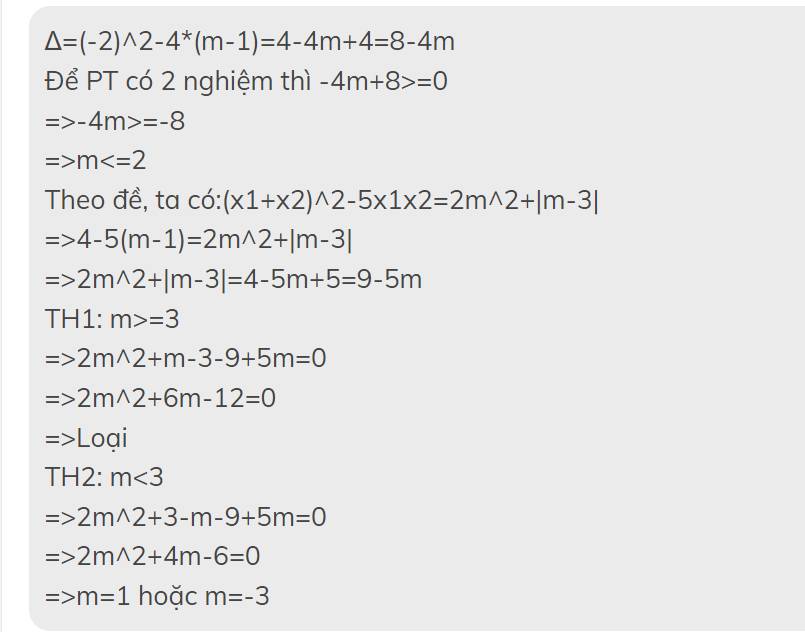Hãy nhập câu hỏi của bạn vào đây, nếu là tài khoản VIP, bạn sẽ được ưu tiên trả lời.

\(\Delta=1-4m>0\Rightarrow m< \dfrac{1}{4}\)
Theo hệ thức Viet: \(\left\{{}\begin{matrix}x_1+x_2=1\\x_1x_2=m\end{matrix}\right.\)
\(\left(x_1^2+x_2+m\right)\left(x_2^2+x_1+m\right)=m^2-m-1\)
\(\Leftrightarrow\left[x_1\left(x_1+x_2\right)-x_1x_2+x_2+m\right]\left[x_2\left(x_1+x_2\right)-x_1x_2+x_1+m\right]=m^2-m-1\)
\(\Leftrightarrow\left(x_1+x_2\right)\left(x_1+x_2\right)=m^2-m-1\)
\(\Leftrightarrow m^2-m-1=1\)
\(\Leftrightarrow m^2-m-2=0\Rightarrow\left[{}\begin{matrix}m=-1\\m=2>\dfrac{1}{4}\left(loại\right)\end{matrix}\right.\)

1.
\(a+b+c=0\) nên pt luôn có 2 nghiệm
\(\left\{{}\begin{matrix}x_1+x_2=m\\x_1x_2=m-1\end{matrix}\right.\)
\(A=\dfrac{2x_1x_2+3}{x_1^2+x_2^2+2x_1x_2+2}=\dfrac{2x_1x_2+3}{\left(x_1+x_2\right)^2+2}=\dfrac{2\left(m-1\right)+3}{m^2+2}=\dfrac{2m+1}{m^2+2}\)
\(A=\dfrac{m^2+2-\left(m^2-2m+1\right)}{m^2+2}=1-\dfrac{\left(m-1\right)^2}{m^2+2}\le1\)
Dấu "=" xảy ra khi \(m=1\)
2.
\(\Delta=m^2-4\left(m-2\right)=\left(m-2\right)^2+4>0;\forall m\) nên pt luôn có 2 nghiệm pb
Theo Viet: \(\left\{{}\begin{matrix}x_1+x_2=m\\x_1x_2=m-2\end{matrix}\right.\)
\(\dfrac{\left(x_1^2-2\right)\left(x_2^2-2\right)}{\left(x_1-1\right)\left(x_2-1\right)}=4\Rightarrow\dfrac{\left(x_1x_2\right)^2-2\left(x_1^2+x_2^2\right)+4}{x_1x_2-\left(x_1+x_2\right)+1}=4\)
\(\Rightarrow\dfrac{\left(x_1x_2\right)^2-2\left(x_1+x_2\right)^2+4x_1x_2+4}{x_1x_2-\left(x_1+x_2\right)+1}=4\)
\(\Rightarrow\dfrac{\left(m-2\right)^2-2m^2+4\left(m-2\right)+4}{m-2-m+1}=4\)
\(\Rightarrow-m^2=-4\Rightarrow m=\pm2\)

d: Ta có: \(\text{Δ}=\left(m+1\right)^2-4\cdot2\cdot\left(m+3\right)\)
\(=m^2+2m+1-8m-24\)
\(=m^2-6m-23\)
\(=m^2-6m+9-32\)
\(=\left(m-3\right)^2-32\)
Để phương trình có hai nghiệm phân biệt thì \(\left(m-3\right)^2>32\)
\(\Leftrightarrow\left[{}\begin{matrix}m-3>4\sqrt{2}\\m-3< -4\sqrt{2}\end{matrix}\right.\Leftrightarrow\left[{}\begin{matrix}m>4\sqrt{2}+3\\m< -4\sqrt{2}+3\end{matrix}\right.\)
Áp dụng hệ thức Vi-et, ta được:
\(\left\{{}\begin{matrix}x_1+x_2=\dfrac{m+1}{2}\\x_1x_2=\dfrac{m+3}{2}\end{matrix}\right.\)
Ta có: \(\left\{{}\begin{matrix}x_1+x_2=\dfrac{m+1}{2}\\x_1-x_2=1\end{matrix}\right.\Leftrightarrow\left\{{}\begin{matrix}2x_1=\dfrac{m+3}{2}\\x_2=x_1-1\end{matrix}\right.\)
\(\Leftrightarrow\left\{{}\begin{matrix}x_1=\dfrac{m+3}{4}\\x_2=\dfrac{m+3}{4}-\dfrac{4}{4}=\dfrac{m-1}{4}\end{matrix}\right.\)
Ta có: \(x_1x_2=\dfrac{m+3}{2}\)
\(\Leftrightarrow\dfrac{\left(m+3\right)\left(m-1\right)}{16}=\dfrac{m+3}{2}\)
\(\Leftrightarrow\left(m+3\right)\left(m-1\right)=8\left(m+3\right)\)
\(\Leftrightarrow\left(m+3\right)\left(m-9\right)=0\)
\(\Leftrightarrow\left[{}\begin{matrix}m=-3\\m=9\end{matrix}\right.\)

PT có 2 nghiệm phân biệt \(\Leftrightarrow\Delta'=\left(m+1\right)^2+32>0\left(\text{đúng }\forall m\right)\)
Theo Vi-ét: \(\begin{cases} x_1+x_2=-2(m+1)=-2m-2\\ x_1x_2=-8 \end{cases}\)
Vì $x_1$ là nghiệm của PT nên \(x_1^2=-2(m+1)x_1+8\)
Ta có \(x_1^2=x_2\)
\(\Leftrightarrow-2\left(m+1\right)x_1+8=x_2\\ \Leftrightarrow x_2+2mx_1+2x_1-8=0\\ \Leftrightarrow\left(x_1+x_2\right)+2mx_1+x_1-8=0\\ \Leftrightarrow x_1\left(2m+1\right)-2m-10=0\\ \Leftrightarrow x_1=\dfrac{2m+10}{2m+1}\)
Mà \(x_1+x_2=-2m-2\Leftrightarrow x_2=-2m-2-\dfrac{2m+10}{2m+1}=\dfrac{-4m^2-8m-12}{2m+1}\)
Ta có \(x_1x_2=-8\)
\(\Leftrightarrow\dfrac{2m+10}{2m+1}\cdot\dfrac{-4m^2-8m-12}{2m+1}=-8\\ \Leftrightarrow\left(2m+10\right)\left(m^2+2m+3\right)=2\left(2m+1\right)^2\\ \Leftrightarrow m^3+3m^2+9m+14=0\\ \Leftrightarrow m^3+2m^2+m^2+2m+7m+14=0\\ \Leftrightarrow\left(m+2\right)\left(m^2+m+7\right)=0\\ \Rightarrow m=-2\)
Vậy $m=-2$

a: Thay m=4 vào phương trình, ta được:
\(x^2-4x+4-1=0\)
=>\(x^2-4x+3=0\)
=>(x-1)(x-3)=0
=>\(\left[{}\begin{matrix}x-1=0\\x-3=0\end{matrix}\right.\Leftrightarrow\left[{}\begin{matrix}x=1\\x=3\end{matrix}\right.\)
b: \(\text{Δ}=\left(-4\right)^2-4\cdot1\left(m-1\right)\)
\(=16-4m+4=-4m+20\)
Để phương trình có hai nghiệm phân biệt thì Δ>0
=>-4m+20>0
=>-4m>-20
=>\(m< 5\)
Theo Vi-et, ta có:
\(\left\{{}\begin{matrix}x_1+x_2=-\dfrac{b}{a}=-\dfrac{\left(-4\right)}{1}=4\\x_1\cdot x_2=\dfrac{c}{a}=m-1\end{matrix}\right.\)
\(x_1\left(x_1+2\right)+x_2\left(x_2+2\right)=20\)
=>\(\left(x_1^2+x_2^2\right)+2\left(x_1+x_2\right)=20\)
=>\(\left(x_1+x_2\right)^2-2x_1x_2+2\left(x_1+x_2\right)=20\)
=>\(4^2-2\cdot\left(m-1\right)+2\cdot4=20\)
=>-2(m-1)+24=20
=>-2(m-1)=-4
=>m-1=2
=>m=3(nhận)

x1+x2=2m-2
2x1-x2=2
=>3x1=2m và 2x1-x2=2
=>x1=2m/3 và x2=4m/3-2
x1*x2=-2m+1
=>8/9m^2-4/3m+2m-1=0
=>8/9m^2+2/3m-1=0
=>8m^2+6m-9=0
=>m=3/4 hoặc m=-3/2
\(x^2-2\left(m-1\right)x-2m+1=0\left(1\right)\)
Để phương trình (1) có 2 nghiệm phân biệt thì:
\(\Delta>0\Rightarrow\left[2\left(m-1\right)\right]^2-4\left(-2m+1\right)>0\)
\(\Leftrightarrow4\left(m-1\right)^2+8m-4>0\)
\(\Leftrightarrow4m^2-8m+4+8m-4>0\)
\(\Leftrightarrow4m^2>0\Leftrightarrow m\ne0\)
Vậy với \(\forall m\ne0\) thì phương trình (1) có 2 nghiệm phân biệt.
Theo định lí Viete cho phương trình (1) ta có:
\(\left\{{}\begin{matrix}x_1+x_2=2\left(m-1\right)\\x_1x_2=-2m+1\end{matrix}\right.\)
Ta có \(2x_1-x_2=2\Rightarrow\left\{{}\begin{matrix}2\left(x_1+x_2\right)-2=3x_2\left(1'\right)\\\left(x_1+x_2\right)+2=3x_1\left(2'\right)\end{matrix}\right.\)
Lấy (1') nhân cho (2') ta được:
\(\left[2\left(x_1+x_2\right)-2\right]\left[\left(x_1+x_2\right)+2\right]=9x_1x_2\)
\(\Rightarrow\left[2.2\left(m-1\right)-2\right]\left[2\left(m-1\right)+2\right]=9\left(-2m+1\right)\)
\(\Leftrightarrow\left(4m-6\right).2m=-18m+9\)
\(\Leftrightarrow8m^2+6m-9=0\)
\(\Leftrightarrow\left[{}\begin{matrix}m=\dfrac{3}{4}\\m=\dfrac{-3}{2}\end{matrix}\right.\)
Thử lại ta có m=3/4 hay m=-3/2


1: \(\Delta=2^2-4\cdot1\left(m-1\right)\)
\(=4-4m+4=-4m+8\)
Để phương trình có hai nghiệm phân biệt thì \(\Delta>0\)
=>-4m+8>0
=>-4m>-8
=>m<2
Theo Vi-et, ta có:
\(\left\{{}\begin{matrix}x_1+x_2=-\dfrac{b}{a}=-2\\x_1\cdot x_2=\dfrac{c}{a}=m-1\end{matrix}\right.\)
\(x_1^3+x_2^3-6x_1x_2=4\left(m-m^2\right)\)
=>\(\left(x_1+x_2\right)^3-3x_1x_2\left(x_1+x_2\right)-6x_1x_2=4\left(m-m^2\right)\)
=>\(\left(-2\right)^3-3\cdot\left(-2\right)\left(m-1\right)-6\left(m-1\right)=4\left(m-m^2\right)\)
=>\(-8+6\left(m-1\right)-6\left(m-1\right)=4\left(m-m^2\right)\)
=>\(4\left(m^2-m\right)=8\)
=>\(m^2-m=2\)
=>\(m^2-m-2=0\)
=>(m-2)(m+1)=0
=>\(\left[{}\begin{matrix}m-2=0\\m+1=0\end{matrix}\right.\Leftrightarrow\left[{}\begin{matrix}m=2\left(loại\right)\\m=-1\left(nhận\right)\end{matrix}\right.\)
2: \(x_1^2+2x_2+2x_1x_2+20=0\)
=>\(x_1^2-x_2\left(x_1+x_2\right)+2x_1x_2+20=0\)
=>\(x_1^2-x_2^2+x_1x_2+20=0\)
=>\(\left(x_1-x_2\right)\left(x_1+x_2\right)+m-1+20=0\)
=>\(-2\left(x_1-x_2\right)=-m-19\)
=>2(x1-x2)=m+19
=>\(x_1-x_2=\dfrac{1}{2}\left(m+19\right)\)
=>\(\left(x_1-x_2\right)^2=\dfrac{1}{4}\left(m+19\right)^2\)
=>\(\left(x_1+x_2\right)^2-4x_1x_2=\dfrac{1}{4}\left(m+19\right)^2\)
=>\(\left(-2\right)^2-4\left(m-1\right)=\dfrac{1}{4}\left(m+19\right)^2\)
=>\(4-4m+4=\dfrac{1}{4}\left(m+19\right)^2\)
=>\(\left(m+19\right)^2=4\left(-4m+8\right)=-16m+32\)
=>\(m^2+38m+361+16m-32=0\)
=>\(m^2+54m+329=0\)
=>\(\left[{}\begin{matrix}m=-7\left(nhận\right)\\m=-47\left(nhận\right)\end{matrix}\right.\)